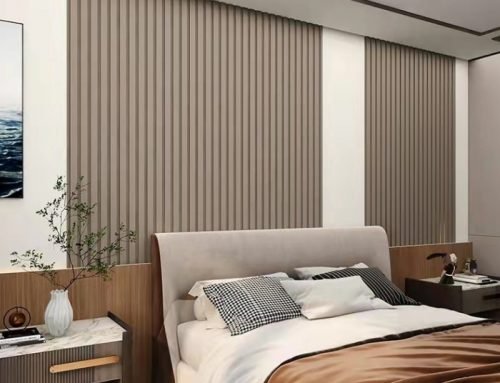Wood-plastic composites are wood-based materials such as veneer, fibres or particles combined with polymers. The term wood-plastic composite is also used interchangeably with wood-polymer composite. WPC boards are relatively new building products comparative to traditional wood composites such as particleboard or fiberboard.
WPC boards are used for doors, windows, flooring, home furnishing and other construction purposes. They are high-quality products that assure ultimate durability and resistance against moisture and heat. Moreover, WPC boards are available in multiple colours and can be designed into desired shapes and sizes.
This article discusses the manufacturing procedure of WPC boards in detail. So, let’s begin:
Raw materials
Wood-plastic composite consists of three types of raw materials:
- Wood fibres / Wood flour
- Thermoplastics
- Additives
A WPC board consists of 15% wood particles, 75% virgin or recycled plastic, and 10% additives.
Wood fibres / Wood flour
In addition to wood fibres, non-cellulose fillers are also used, such as peanut hulls, coffee husk, pulp fibres, bamboo, straw, digestate, etc. and other agricultural and industrial waste.
Thermoplastics
Thermoplastics used in WPC boards manufacturing can be either virgin or recycled. These include high-density polyethylene (HDPE), low-density polyethylene (LDPE), polypropylene (PP), polystyrene (PS), polyvinyl chloride (PVC), acrylonitrile butadiene styrene (ABS), and polylactic acid (PLA). However, PE-based plastics are used most commonly.
Additives
Additives are fairly significant ingredients of WPC boards, which are added to enhance the WPC properties. Generally, they include lubricants, rheology control additives, fillers, coupling agents, and biocides (zinc borate, Na/Ca borate). Some stabilizers like hindered amine light stabilizers and ultraviolet absorbers protect WPC against UV. Besides, the WPC boards also contain density reduction additives, smoke suppressants and fire retardants such as melamine phosphate and ammonium polyphosphate.
WPC boards Manufacturing process
Wood-plastic composites are produced by mixing the groundwood particles with heated thermoplastics. Afterwards, this heated blend is extruded or moulded into desired shapes.
Various WPC manufacturing steps are:
- Extrusion
- Injection moulding
- Inspection
Extrusion
The majority of WPC boards are manufactured with an extrusion process. The extrusion’s primary purpose is to melt thermoplastics and compounding, which is referred to as the mixing of melted thermoplastic with wood and additives. After compounding, the extruder transfers the wood-plastic mixture to die. The extrusion systems used in WPC processing are:
- Single-Screw Extruder
- Counter-Rotating Twin-Screw Extruder
- Counter-rotating twin screw Extruder
- Single-Screw Extruder
Single-Screw Extruder is the simplest extrusion system for WPC formation. Two basic stages of this extruder are melting and metering; moreover, there is also a vent section for the removal of volatiles. However, it has low output rates and requires a dryer for drying fibre-filled plastic pellets.
- Counter-rotating twin-screw Extruder
Counter-rotating twin-screw extruders are employed for heat-sensitive polymers like PVC, low-temperature extrusion, and those materials that require degassing. It is a proven technology that offers low shear mixing and low screw speed. But a dryer, milling system and pre-blending system is required with it.
- Co-rotating twin screw Extruder
Co-rotating twin screw Extruder is great for processing wood at ambient moisture content. No additional drying system is required because the extruder dry the fibre itself. However, it has a few disadvantages, including high screw speed and inability to keep melt temperature low with higher head pressures.
Injection moulding
Injection moulding involves injecting melted wood-plastic mixture in the mould to produce WPC boards of the defined cross-section. Generally, it is used to manufacture boards with complex geometries and requires no finishing step. However, this process is less common than extrusion and used in the preparation of automobile WPC parts.
Inspection
Once WPC boards are formed, they are vigorously tested before launching in the market. Inspection tests include:
- Thermal testing
- Dimension stability testing
- Water thickness swelling testing
- Flexural strength testing
- Formaldehyde emissions testing
- Heavy metals testing
Wood modification
Wood fibres are hydrophilic because of cellulose and hemicellulose molecules, while thermoplastics are hydrophobic. Therefore, wood fibres can agglomerate during compounding, which will lead to incomplete dispersion of wood fibres in thermoplastic and inferior quality WPC will form. Thus, modification of the wood fibre is very critical to making improved WPCs.
Wood modification can be done in three ways:
- Thermal treatment
- Chemical treatment
- Energetic treatment
Thermal treatment
In thermal treatment, the wood fibres are exposed to heat and moisture at 230°C to eliminate hemicellulose from the surface.
Chemical treatment
In chemical treatment, coupling agents add functional moieties to wood fibres. This modification in functional groups of wood fibres improves their interfacial bonding with the thermoplastic.
Energetic treatment
An energetic treatment, the atmospheric glow discharge (AGD) technique, treats the wood fibres with gases at atmospheric pressure. It facilitates the uniform dispersion of wood fibres in thermoplastic.
That’s all about the manufacturing process of WPC boards.




